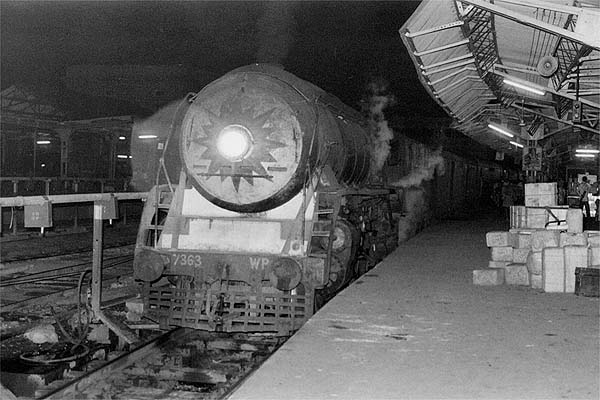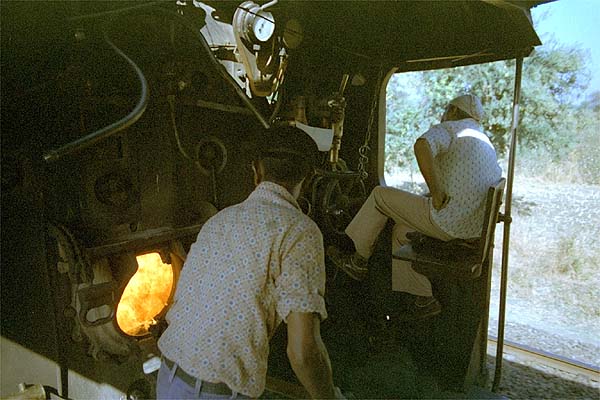|
Case
Notes - India, 1982-5, Round 2 |
|
|
Terry Case writes about his travels for steam. Further tales will follow from time to time covering more of Australia, India, South Africa, Indonesia and Pakistan. Click here for the Case Notes Index, which includes many earlier Indian tales. On 20th January 1983, WP 7000 is ready to depart Nagpur on the Delhi Janata.
Gandhi had chosen to make his ashram in central India near Wardha Junction (79km from Nagpur). Railways were the prime reason to settle there. From Nagpur trains could take him quickly to the State capitals and bring guests to meet him at Wardha. I chose to start this series in this central area, the following reports are based on trips made between 1982 and 1985. The railways between Nagpur and Bhusaval to Bhopal in Central India proved a happy hunting ground for steam action in the early 1980s. A favourite service was 133/4 which ran overnight between Nagpur and Bhusaval. The train ran on selected days between Ahmadabad on the west coast to Howrah in the East, it was typical of the long distance steam hauled expresses of this period. The train was hauled by a Western Railway electric from Ahmadabad to Surat where a WP took over to Bhusaval. A Central Railway WP then took it overnight to Nagpur and early next morning it would depart for Raipur behind a SER WP. The final stage would be electric to Howrah. I enjoyed the atmosphere of a busy Indian Railway station at night and both Bhusaval and Nagpur had plenty of steam action on overnight trains at this time. On 30th December 1981 I had flown into Bombay to start my second trip to India, that night I walked along the long platform at Bhusaval and found a gleaming WP 7034 quietly sizzling away awaiting the arrival of 133 express. The driver invited me to join him in the cab and proudly explained the controls for me. At 20.00 another clean WP 7422 arrived on a passenger from Nagpur whilst yet another of the class backed down onto the Itarsi stopper, plenty of activity! When the crew of 7034 got word that the arrival of 133 was imminent (45 minutes late) the fireman put on a big fire. I left in time to get an arrival shot of Western Railway WP 7461 which carried a Hindi script headboard proclaiming “Howrah Express”. Hindi was the language of many in Central and Northern India, but it was not widely spoken in the West, East or South of the country. English was the common second language for the educated sectors of the population and that included most railwaymen. 133 departed Nagpur the next morning at 06.30 behind a South Eastern Railway WP, it was still too dark for a still shot. Like other SER locos, the engine number was painted in large numerals on the tender. On the 19th January 1983, I had arrived at Nagpur behind SER WP 7363 on 134 Express, running 15 minutes late. I had joined the train at Gondia after photographing the narrow gauge there. Despite some fast running over sharp grades it had not regained any time on reaching Nagpur.
Here I took some flash photos and attracted the attention of Carriage Superintendent, Mr Woods, he was quite happy for me to photograph and took me to the sidings especially where pristine CR WP 7034 was ready to take over 134, déjà vu as a year earlier this engine was in charge of the Bhusaval to Nagpur train that I had ridden.
As I walked back another CR WP, again in good external condition, was seen arriving on the late running Madras to Delhi Janata. This was the last year that long distance steam hauled express trains would be seen in any quantity, the end of an era was approaching. Janata means People, these express trains were formed with an unreserved sitting carriage and 2 tier and 3 tier 2nd class sleepers. They offered long distance travel at low prices, truly a service for the population. I was becoming interested in the lives of Anglo-Indian rail workers in the period after Indian Independence. Nagpur was home to a number of these men whose friendly tolerance of railfans was greatly appreciated. Two decades later I contacted a number of ex-drivers who had retired to Australia and they generously gave me an insight into their working lives and their community’s history. Driver Moon was another Anglo-Indian I met at Nagpur, he was the driver for the overnight Delhi bound Janata Express on 20th January 1983. WP 7000 which had been waiting on a centre road was brought forward and exchanged with 7430, both engines looked in good condition and were decorated. The crew on 7000 were led by Driver Moon, (an appropriate name for a man on night duty), they in turn were to be relieved after travelling 300km and take rest, they would return with another train the next day. 300km may not seem far, but these trains were not speedsters!
Another night service in winter was the 18.00 to Katni. This was the sole steam duty left on the ng at Nagpur. Unfortunately this was not going out in a blaze of glory, the unkempt condition of the BS and the train’s snail like speed suggested the crew would be glad to be rid of their elderly loco. On 20th January 1983, WP 7021 passes the signal box as it enters Nagpur on the Madras bound Janata.
Earlier on 31st December 1981, I had boarded 400, a fast passenger to Bhusaval.at Nagpur. It was described as an express in the timetable but it turned out to be a fiction, it looked and behaved like a fast passenger at best. The engine assigned WP 7004 not only had an embossed Star of India, but also decorated buffers. The driver Rupert Murze invited me to join them on the footplate, here he glances at his permanent way warnings as the second fireman is on the lookout and ready to sound the whistle.
At Khopri, a track gang and their trolley somehow crammed in the cab to ride a couple of sections; Driver Murze assured me there was no problem, he was used to large numbers of cab riders! The “express” actually called at all the stations that according to the timetable we were booked to pass. Many passengers got on and off indicating the train usually stopped at these points! Rupert told me the details shown on the engine cabsides related to repairs, the name painted on the cab was not that of the driver, but of the inspector responsible for the maintenance of the locomotive. The WP was a real bone shaker once it got over 75 kmph. The line is dead straight in places so there are long stretches where the engine was working at 85kmph, the top speed I noted was a 90 on a couple of sections. My perch on the tender was probably the most comfortable. An indication of how the crew felt was when both firemen retreated to the tender, leaving the driver perched on his wooden stool to deal with the vibrations. Firing involved rounds of 10-15 shovels, I did not note excessive smoke so from the lineside photography was not as exciting as cab riding. Rupert worked the engine with the regulator full open, the reverser was used to control speed whilst he kept a hand on the brake valve or the reverser when running. With the line clear the first fireman stokes the fire.
Rupert told me he had been working for the railways for 27 years, so he would have started when I was born in 1954. It had only been in the last seven years he had started to drive, a long apprenticeship. The second firemen dealt with the flags that were displayed when leaving stations and passing signal cabins. The signal man exchanged waves, flags were also displayed when passing oncoming trains. There was a lot of use of the whistle – as a large number of track gangs seemed to be at work, on one section the whistle was blowing almost continuously for a couple of km as we rolled cautiously along at 70kmh, the noise in the cab was ear piercing. At Wardha Junction the fire was cleaned with the aid of a service crew who also attended the water column, leaving both firemen the chance to have a tea at the short stop. Rupert now removed his leather headpiece which had included ear flaps worn against the cold morning air. The departure from here whilst slow still caught some intending passengers unprepared and Rupert stopped the engine in the middle of two sets of points in the yard to allow people to join the “express”. Pulgaon was reached at 11.00 where I left the train. I found a new local timetable posted here that showed increased running time had been allocated to train 400, the train had been downgraded to a local passenger. The crew quickly checked the engine which I noted had a mixed set of Boxpox and spoked wheels, Rupert explained that the Boxpox wheels were fitted with roller bearings and were self-oiling, whilst spoked wheels had to be checked at each major stop. Parts were becoming interchanged during overhauls; to the extent it was rare to see an engine with a matched set of wheels. At the tea stall next to the ng platform I discussed cricket with the customers as a radio broadcast the Australia Test against the West Indies. England was due to start the Fourth Test against India in Calcutta the next day, there was no shortage of opinions in this cricket mad society. I crossed over to the ng platform as the train was due to leave, I fooled nobody and was mobbed by a large crowd. I could only get some close-ups of the Pulgaon Railway crest on the tender and shots of the fireman oiling around ZP 2. The line remained privately owned, but operated by Indian Railways..
I tried to lose my crowd by walking up to the shed, the light was hopeless and watching a modern steam engine haul 3 carriages tender first on suspect track was not enticing. I spent later years seeking older engines on more challenging workings. Outside the shed were the three A1 2-8-4T tanks which had been withdrawn in September / October 1977. Other Round 2 Indian Tales:
|







